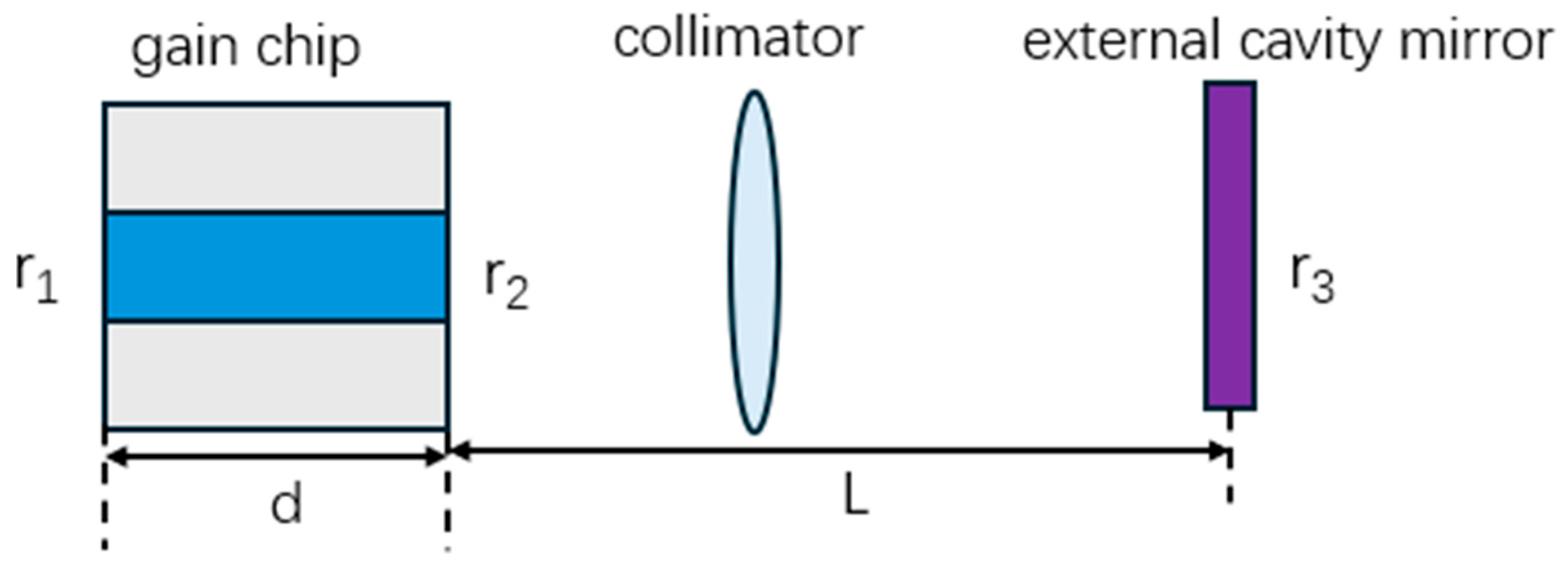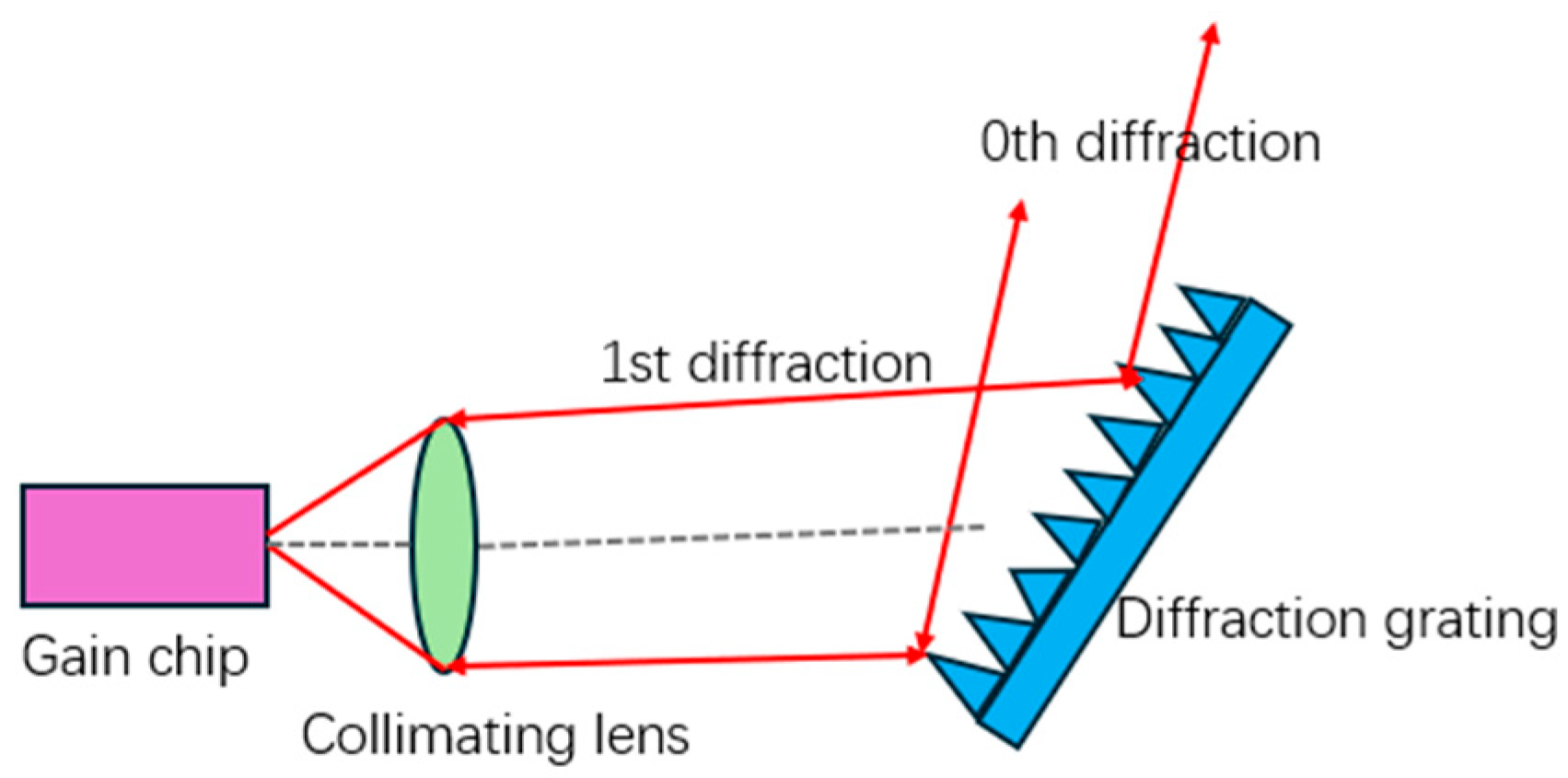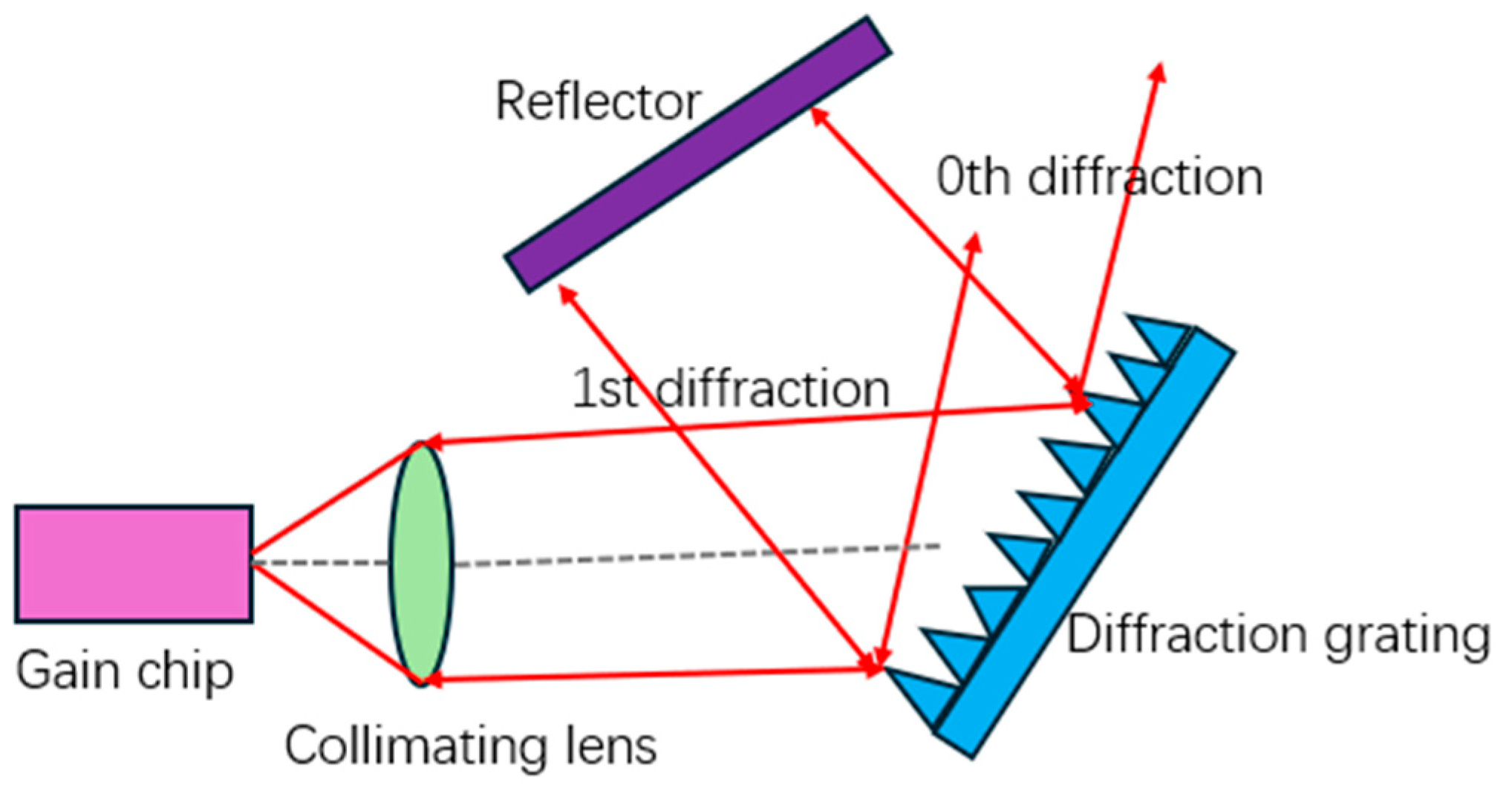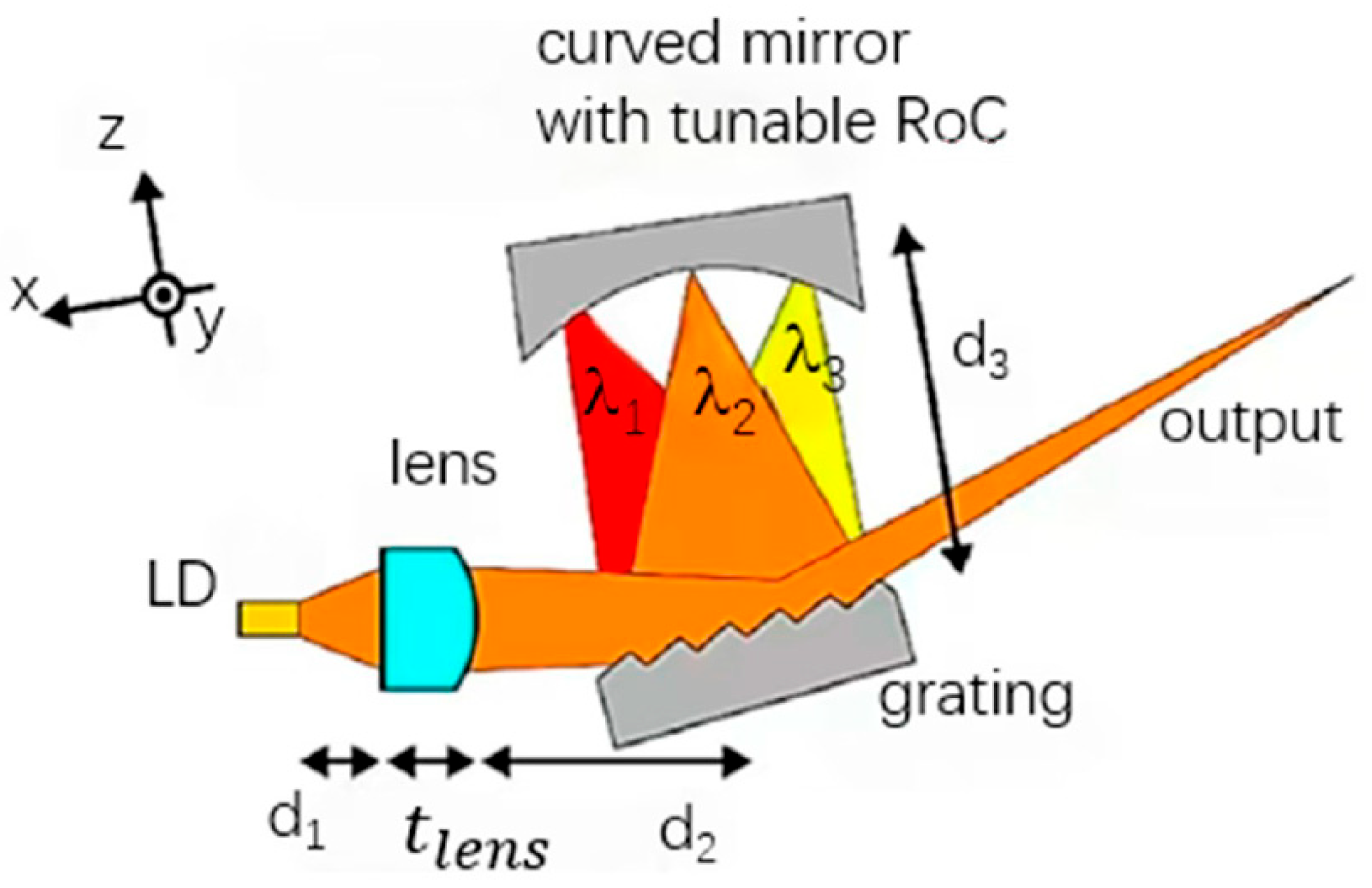In recent years, the NBTECDL has been extensively studied by researchers due to its broadband tuning range and narrow linewidth. This article will introduce the latest research progress on diffraction-grating-type, FBG-type, and waveguide-type NBTECDLs.
4.2. Research Progress on FBG-Type NBTECDLs
Research on FBG-type NBTECDLs abroad started earlier. Initially, the F–P cavity coupled with the outer cavity of the FBG studied by the British Telecom laboratory achieved a linewidth output of 50 kHz. Subsequently, Bell Laboratories in the United States and NTT Corporation in Japan also carried out research on the outer cavity lasers of the FBG. In recent years, domestic scientific research institutions such as the Institute of Semiconductors of the Chinese Academy of Sciences and the Shanghai Institute of Optics and Fine Mechanics have also conducted research on FBG-type NBTECDLs.
In 2017, Zhang et al. [
48] designed a mode-free NBTECDL using glued and filled V-slot packaging technology, achieving a continuous mode-free tuning range of up to 0.5 nm (5 times the cavity pitch), a narrow linewidth of 35 kHz, and a high linear thermal tuning speed of 65 pm/°C (8.125 GHz/°C).
In 2018, Yan Z et al. [
49] modeled the theoretical model of FBG using the transfer matrix method (TMM). The influences of the length of the Bragg grating and the modulation depth on the reflectance, the spectral width of the grating, and the wavelength were studied. Then 976 nm laser modules with different grating reflectances (i.e., 4%, 6%, 8% and 10%) were fabricated. Optimizing the reflectivity of FBG via TMM simulation, the SMSR was optimized to above 40 dB, and the threshold current was decreased.
In 2019, Yang et al. [
50] reported a 1550 nm continuously tunable laser using chirped FBG and SOA. The line width of the laser was less than 0.03 nm and the SMSR was greater than 25 dB. It could be continuously tuned to approximately 48 nm (1526.02–1573.91 nm), and the power variation within the tuning range was only 1.46 dB.
In 2020, Song-Sui L et al. [
51] conducted a numerical study on the periodic 1 (P1) oscillation of diode lasers under the optical feedback of narrowband FBG. The FBG had a narrow bandwidth less than the laser relaxation oscillation frequency. FBG feedback could reduce microwave linewidth and phase noise by maintaining a stronger feedback power, and improved the side peak rejection ratio (SPSR) by filtering the external cavity mode. The FBG feedback reduced the microwave linewidth by more than an order of magnitude and increased the SPSR by more than two orders of magnitude compared to the mirror feedback using the same delay time.
In 2021, Antoine C et al. [
52] achieved an InGaN-based diode laser tube with an emission wavelength of 400 nm based on an FBG. Research has expanded the short wavelength band. This device had an SMSR of 44 dB and an output power of mW. Detailed frequency noise analysis revealed the sub-MHz integral line width and the 16 kHz natural linewidth.
In 2022, Su et al. [
16] reported on a frequency-stabilized narrow linewidth FBG-type NBTECDL for lidar used in carbon dioxide detection. The FBG-type NBTECDL module was integrated in a compact butterfly package, with a transmission wavelength of 1572.02 nm, a continuous tuning frequency of 22 GHz (approximately 0.173 nm), and an SMSR greater than 50 dB. At an injection current of 340 mA, the output power was 30 mW. The linewidth of the NBTECDL was 15 kHz.
In 2022, Jingjing Y et al. [
53] developed a novel single-chip dual-wavelength conical semiconductor laser tube based on a composite distributed Bragg reflection (DBR) grating, leading to a significant improvement in integration density. At a ridge current of 190–300 mA and a heat sink temperature of 20 °C, the conical diode laser tube achieved dual-wavelength emissions at wavelengths of 1025.4 nm and 1036.2 nm, respectively. The line widths of both wavelengths were less than 36 pm, and the minimum power difference between the two wavelengths was 1.2 dB. By adjusting the heat sink temperature of the conical semiconductor laser tube from 13.8 °C to 20.7 °C, the spectral distance between the two wavelengths could be modulated to 10.4 nm to 10.9 nm.
In 2022, Ye L et al. [
54] introduced a 405 nm external cavity semiconductor laser using a volumetric Bragg grating (VBG) as the feedback element. The emission wavelength of the semiconductor laser was stably locked at 405.1 nm, and the spectral line width was 0.08 nm. The output power reached 292 mW, and the wavelength was reduced to 0.0006 nm/°C with temperature drift.
In 2024, Jiaqi C et al. [
55] demonstrated the NBTECDL with linear polarization and a narrow linewidth. In polarization-maintaining fibers (PMF), birefringent Bragg gratings fabricated by femtosecond laser point-by-point technology were used to provide external cavity feedback. The NBTECDL achieved an output power greater than 60 mW and a polarization–extinction ratio (PER) greater than 30 dB, addressing the issue of no polarization control in traditional FBG. The Lorentz line width of 2.58 kHz was obtained based on the delay self-heterodyne beat frequency measurement.
In 2024, Duraev V et al. [
56] reported the manufacturing results of a single-frequency tunable semiconductor laser module with a wavelength of 1550 nm, whose outer cavity was based on an FBG formed in a single-mode optical fiber. The laser module could generate dynamic and stable single-frequency radiation. The side mode suppression exceeded 40 dB, the laser linewidth was 100 kHz, and the output optical power was higher than 50 mW. The wavelength of the emission spectrum of the laser module was tuned to 2 nm.
In 2025, Huang Z et al. [
57] proposed a dual-wavelength output composite grating DFB laser, which achieved the selection of two longitudinal modes through transversely coupled gratings and ridge gratings of different periods. At a current of 0.4 A and a voltage of 2.83 V, the device achieved an output power of 78.28 mW, with a threshold current of approximately 0.13 A. When the working current was between 0.28 A and 0.35 A, the device maintained a stable dual-wavelength output with a wavelength separation of approximately 0.75 nm. The maximum measured dual-wavelength output power was 71.95 mW.
The FBG-type NBTECDL has the advantages of simple structure, low noise output, small size, low cost, good stability and low cost. The line width of this laser can reach several kHz, or even below 1 kHz, which is its most prominent feature. However, due to the limited tuning method, the wavelength tuning range is very small.
Table 4 summarizes the research progress on FBG-type NBTECDLs in recent years. At present, the preparation process of FBG-type NBTECDLs is relatively mature and can be widely applied in the fields of distributed fiber optic sensing, coherent spectral analysis, synthetic aperture radar, etc.
From 2017 to 2025, research on FBG-type NBTECDLs has yielded substantial progress, with core strengths centered on targeted performance optimization, scenario-specific adaptation, and functional diversification. The study [
48] leveraged glued-and-filled V-slot packaging to develop a mode-free NBTECDL, achieving a 0.5 nm continuous mode-free tuning range, 35 kHz narrow linewidth, and 65 pm/°C high linear thermal tuning speed. Subsequent breakthroughs expanded key metrics: Yang et al. [
50] utilized chirped FBGs and semiconductor optical amplifiers (SOAs) for a 1550 nm laser with a 48 nm tuning range and only 1.46 dB power fluctuation, and Jiaqi C et al. [
55] integrated femtosecond-laser-written birefringent FBGs in polarization-maintaining fibers (PMFs) to achieve an NBTECDL with a 2.58 kHz ultra-narrow Lorentz linewidth and 60 mW output power. Huang Z et al.’s [
57] composite-grating DFB laser (78.28 mW output, stable 0.75 nm separated dual wavelengths). Scenario-specific designs were refined too, such as Su et al.’s [
16] butterfly-packaged FBG-based NBTECDL for CO
2 detection lidar.
However, there are limitations: some studies exhibit a narrow tuning range [
16] (0.173 nm), certain devices still have significant room for linewidth optimization (100 kHz) [
56], and dual-wavelength devices feature a small wavelength spacing [
57], which makes it difficult to meet the requirements of some wide-spacing applications. FBG-type NBTECDLs are advancing toward the simultaneous realization of a narrow linewidth, high power, a wide tuning range, a high SMSR/PER, and low wavelength drift. Meanwhile, they are developing in the direction of being tailored for scenarios such as lidar and gas detection, supporting characteristic outputs including dual-wavelength and linear polarization, and achieving integrated miniaturization.
4.3. Research Progress on Waveguide-Type NBTECDL
The waveguide-type NBTECDL has the characteristics of a narrow linewidth and broadband tuning range of the outer cavity, and at the same time possesses the features of low loss, high integration and high reliability of single-chip integrated lasers. Due to its excellent characteristics, it has been favored by researchers.
In 2016, Youwen Fan et al. [
58] demonstrated the first integrated InP-Si
3N
4 hybrid laser. The outer cavity of the exciter was composed of two cascaded MRRs, which were used to perform single-frequency operation under a narrow-band spectral bandwidth, achieving a tuning range of over 43 nm, with an SMSR of 35 dB and a minimum linewidth of 90 kHz.
In 2017, H. Ishii et al. [
59] used a DFB array structure as the light source and mixed and integrated the lens group with a 129 mm long waveguide on a SiO
2/Si platform; ultimately narrow linewidths of less than 10 kHz were obtained over the entire C-band. However, the 129 mm long waveguide resulted in an excessively large overall size of the device.
In 2018, Yu Li et al. [
60] coupled commercial FP diode lasers with external high-Q value micro-resonators. The laser achieved a wavelength tuning range of 17 nm, a narrow linewidth of 8 kHz, an output power of 7 dBm (50 mW), and an SMSR of 45 dB. The narrow tuning range fails to meet the requirements of wide-wavelength-band applications.
In 2019, Zhu et al. [
61] demonstrated a hybrid integrated dual-band laser of InP/GaAs RSOA and SiN. The laser provides tunable external cavities for both InP and GaAs gain chips simultaneously. The spectral linewidth-divisions are 18 kHz and 70 kHz, and the SMSR divisions are 52 dB and 46 dB. The tuning ranges of 46 nm and 38 nm were achieved, respectively, at 1.55 μm and 1 μm.
In 2020, Fan et al. [
62] fabricated a hybrid integrated InP-Si
3N
4 NBTECDL with an intrinsic linewidth of 40 Hz, a maximum output power of 23 mW (fiber coupling), spectral coverage greater than 70 nm (C-band) at 3 mW, and SMSR > 60 dB. The study achieved a narrow linewidth and high SMSR, yet suffered from insufficient output power and tuning flexibility.
In 2021, Xiang et al. [
63] integrated a laser on a SiN waveguide, achieving a sub-khz linewidth and an output power of tens of milliwatts. In the same year, the traditional DFB laser was self-injected and locked to the Si
3N
4 micro-ring resonator. The noise was reduced by five orders of magnitude, achieving a frequency noise of 0.2 Hz
2/Hz and a short-term linewidth of 1.2 Hz.
In 2021, Dass et al. [
64] demonstrated a new type of InP-Si
3N
4 dual laser module. Each one was fabricated using a hybrid coupling of InP-based SOA and low-loss Si
3N
4 feedback circuits. The work reduced coupling loss and improved integration density. This work proposed the NBTECDL can be tuned over 100 nm while maintaining a SMSR greater than 50 dB and RIN approximately −160 dB/Hz.
In 2022, Mateus Z C et al. [
65] achieved coarse tuning up to 12.5 nm and mode-free fine-tuning up to 33.9 GHz using micron-scale Si
3N
4 resonators and commercial Fabry–Perot semiconductor laser tubes, with an inherent linewidth as low as several thousand Hertz. Furthermore, we also demonstrated a fine-tuning speed of up to 267 GHz μs
−1, a fiber-coupled power of up to 10 mW, and a typical side-mode rejection ratio higher than 35 dB.
In 2023, Chen et al. [
66] reported a hybrid integrated Si
3N
4 NBTECDL with full C-band wavelength stability and narrow-linewidth output. The InP gain chip was coupled with the Si
3N
4 dual micro-ring and then integrated with the AlGaInAs quantum well rib waveguide SOA through dual collimating lens coupling. A wavelength tuning range of 55 nm, an SMSR exceeding 50 dB, a high output power of 220 mW, and a linewidth less than 8 kHz were obtained.
In 2023, Nouman Z et al. [
67] first demonstrated a widely tunable GaSb/Si
3N
4 hybrid laser with a wavelength of approximately 2 μm. The study expanded the long-wavelength band. The hybrid laser demonstrated a relatively high continuous output power of 15 mW, a low threshold current of 100 mA, and a broadband tuning range of approximately 90 nm, covering wavelengths between 1937 nm and 2026 nm.
In 2025, Li S et al. [
17] introduced the application of a four-layer Nb
2O
5/SiO
2 thin film system in RSOA, which showed a 3 dB spectral width of 79.4 nm in its spontaneous emission spectrum, covering the wavelength range from 1497.2 nm to 1576.6 nm. Within this range, the ripple remained below 1 dB, and the ripple near 1550 nm was as low as 0.5 dB. Under the test conditions of 25 °C and 180 mA, the line width of the external cavity laser was 299.8 Hz, and the output power was 12.6 mW. A four-layer Nb
2O
5/SiO
2 thin film system was introduced to optimize the spectral ripple of the RSOA, continuously approaching the “quantum-limited narrow linewidth”.
Table 5 summarizes the performance of the waveguide-type NBTECDL. For the waveguide-type NBTECDL, its greatest advantage lies in its high integration, flexible selection of frequency selection components, and the ability to achieve a long effective cavity length. It has a narrow linewidth, broadband tuning range and noise performance, and has a very good commercial preparation and application prospect.
From 2016 to 2025, research on waveguide-type NBTECDLs has achieved continuous breakthroughs, with core advantages focusing on the progressive optimization of key performance indicators and the expansion of application scenarios. The study [
58] pioneered InP-Si
3N
4 hybrid lasers with a tuning range of over 43 nm and SMSR of 35 dB. Subsequent works continuously narrowed the linewidth from 90 kHz (2016) to sub-kHz, even 1.2 Hz [
63] and 299.8 Hz [
17], while expanding the tuning range to 100 nm [
64] and extending the wavelength to the 2 μm band [
67]. Additionally, the output power was significantly improved (up to 220 mW) [
66] and the SMSR was enhanced to over 60 dB [
62], with material systems evolving from InP-Si
3N
4/GaAs to GaSb-Si
3N
4 and four-layer Nb
2O
5/SiO
2 [
17], and integration structures advancing from cascaded MRRs and DFB arrays to dual-band lasers and NBTECDLs. However, there are still limitations: some early studies had narrow tuning ranges (17 nm) [
60], high-power designs occasionally sacrificed linewidth performance [
66], and non-C-band lasers (2 μm) [
67] had lower output power (15 mW) than C-band counterparts, with partial reliance on commercial devices restricting full integration. The overall trend is clear: hybrid integrated lasers are moving toward diversified material systems, broader wavelength coverage, synergistic improvement of multi-performance metrics (narrower linewidth, broadband tunable, higher power, higher SMSR), and higher integration density, gradually meeting the demands of high-performance photonic applications.












